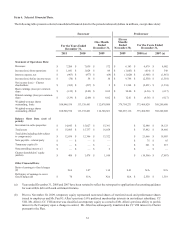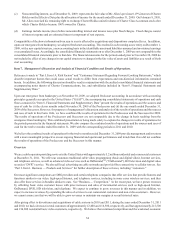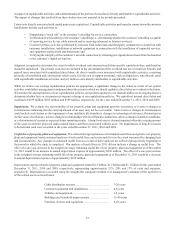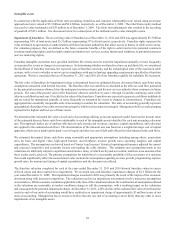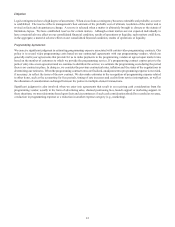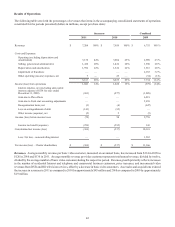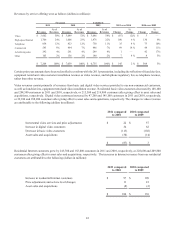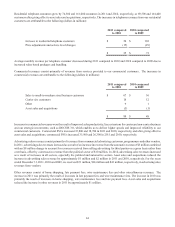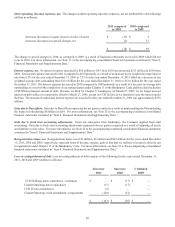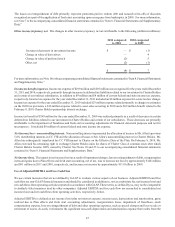Charter 2011 Annual Report Download - page 49
Download and view the complete annual report
Please find page 49 of the 2011 Charter annual report below. You can navigate through the pages in the report by either clicking on the pages listed below, or by using the keyword search tool below to find specific information within the annual report.37
in support of capitalizable activities, and a determination of the portion of costs that is directly attributable to capitalizable activities.
The impact of changes that resulted from these studies were not material in the periods presented.
Labor costs directly associated with capital projects are capitalized. Capitalizable activities performed in connection with customer
installations include such activities as:
• Dispatching a “truck roll” to the customer’s dwelling for service connection;
• Verification of serviceability to the customer’s dwelling (i.e., determining whether the customer’s dwelling is capable
of receiving service by our cable network and/or receiving advanced or Internet services);
• Customer premise activities performed by in-house field technicians and third-party contractors in connection with
customer installations, installation of network equipment in connection with the installation of expanded services,
and equipment replacement and betterment; and
• Verifying the integrity of the customer’s network connection by initiating test signals downstream from the headend
to the customer’s digital set-top box.
Judgment is required to determine the extent to which overhead costs incurred result from specific capital activities, and therefore
should be capitalized. The primary costs that are included in the determination of the overhead rate are (i) employee benefits and
payroll taxes associated with capitalized direct labor, (ii) direct variable costs associated with capitalizable activities, consisting
primarily of installation and construction vehicle costs, (iii) the cost of support personnel, such as dispatchers, who directly assist
with capitalizable installation activities, and (iv) indirect costs directly attributable to capitalizable activities.
While we believe our existing capitalization policies are appropriate, a significant change in the nature or extent of our system
activities could affect management’s judgment about the extent to which we should capitalize direct labor or overhead in the future.
We monitor the appropriateness of our capitalization policies, and perform updates to our internal studies on an ongoing basis to
determine whether facts or circumstances warrant a change to our capitalization policies. We capitalized internal direct labor and
overhead of $199 million, $205 million and $199 million, respectively, for the years ended December 31, 2011, 2010 and 2009.
Impairment. We evaluate the recoverability of our property, plant and equipment upon the occurrence of events or changes in
circumstances indicating that the carrying amount of an asset may not be recoverable. Such events or changes in circumstances
could include such factors as the impairment of our indefinite life franchises, changes in technological advances, fluctuations in
the fair value of such assets, adverse changes in relationships with local franchise authorities, adverse changes in market conditions,
or a deterioration of current or expected future operating results. A long-lived asset is deemed impaired when the carrying amount
of the asset exceeds the projected undiscounted future cash flows associated with the asset. No impairments of long-lived assets
to be held and used were recorded in the years ended December 31, 2011, 2010 and 2009.
Useful lives of property, plant and equipment. We evaluate the appropriateness of estimated useful lives assigned to our property,
plant and equipment, based on annual analyses of such useful lives, and revise such lives to the extent warranted by changing facts
and circumstances. Any changes in estimated useful lives as a result of these analyses are reflected prospectively beginning in
the period in which the study is completed. Our analysis of useful lives in 2011 did not indicate a change in useful lives. The
effect of a one-year decrease in the weighted average remaining useful life of our property, plant and equipment as of December
31, 2011 would be an increase in annual depreciation expense of approximately $210 million. The effect of a one-year increase
in the weighted average remaining useful life of our property, plant and equipment as of December 31, 2011 would be a decrease
in annual depreciation expense of approximately $165 million.
Depreciation expense related to property, plant and equipment totaled $1.3 billion, $1.2 billion and $1.3 billion for the years ended
December 31, 2011, 2010 and 2009, respectively, representing approximately 21%, 20% and 17% of costs and expenses,
respectively. Depreciation is recorded using the straight-line composite method over management’s estimate of the useful lives
of the related assets as listed below:
Cable distribution systems………………………………
Customer equipment and installations…………………..
Vehicles and equipment…………………………………
Buildings and leasehold improvements…………………
Furniture, fixtures and equipment….……………………
7-20 years
4-8 years
1-6 years
15-40 years
6-10 years








